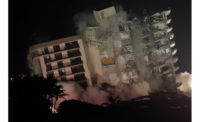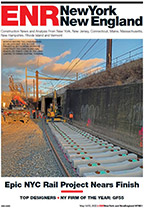Designers Call for Coordinated Effort To Improve New York City Region's Flood Resistance

Seven months after miles of New York and New Jersey waterfront were slammed by Superstorm Sandy’s surge, the area's design and planning groups are calling for the creation of a pan-regional entity to organize and lead the effort to deal with flood-resilience and climate change. They also are trumpeting the need for other reforms to eliminate myriad obstacles to climate adaptation, including the creation of a so-called Waterfront Lab to test innovative systems to make flood-prone areas more resilient.
“There is a disaster of different levels of government and some parts of the same government not talking to each other,” said Mark Ginsberg, a principal of the local Curtis+Ginsberg Architects LLP, at the "Future of the City" symposium, held on May 12 in New York City and hosted by the American Institute of Architects New York Chapter (AIANY).
The problems go beyond barriers to flood-resilience. “New York City’s zoning resolution is old, cumbersome and difficult to understand by professionals and lay people alike,” added Jill Lerner, 2013 AIANY president. “Zoning does not take into account the threat of climate change, and transportation and zoning issues are not being coordinated,” said Lerner, a principal with the local architect-planner Kohn Pedersen Fox.
The AIANY forum was held to introduce two 42-page reports just published by AIANY: Post-Sandy Initiative—Building Better, Building Smarter: Opportunities for Design and Development and A Platform for the Future of the City.
AIANY is using the reports to make sure its voice is heard as local, state and federal government officials plot the next steps to make infrastructure, buildings and the waterfront more resistant to flooding. This week, the New York Dept. of City Planning is expected to release its second round of proposed post-Sandy zoning changes. The Dept. of Buildings is expected to issue proposed building-code changes in the next month or two.
AIANY felt especially left out of the post-Sandy conversation because New York State Gov. Andrew M. Cuomo’s 30-member NYS 2100 Commission, which issued a report earlier this year on ways to improve the resilience and strength of the state’s infrastructure in the face of natural disasters and other emergencies, did not include a single architect.
To spread the gospel of the design community, AIANY is distributing the reports to local, state and federal government officials and politicians, including the candidates currently running for New York City mayor. “AIANY has identified the 2013 citywide elections as the moment to advance the discussion about the connection of design and public policy,” write Lerner and Rick Bell, AIANY’s executive director, in the foreword of the "Future of the City" report.
Mayoral hopefuls were invited to the May 12 forum, but none came, said Bell.
For the Sandy report, to present a united front, AIANY engaged seven other local design and planning groups to jointly explore solutions for sustainability and resiliency in areas of transportation and infrastructure, housing, critical and commercial buildings, and the waterfront.
The undertaking, led by the AIANY’s design for risk and reconstruction committee, engaged more than 150 volunteers from AIANY, the American Council of Engineering Cos., the American Society of Landscape Architects, the Citizens Housing and Planning Council, the New York State Association of Affordable Housing, the American Planning Association, the Regional Plan Association and the Structural Engineers Association of New York.
At the forum, there was criticism of the Federal Emergency Management Agency because its regulations governing the design and construction of housing in flood zones are geared more toward the suburbs and do not fully take into account flood-proofing in the densest urban environment in the U.S. “FEMA lacks material for New York City,” said Ginsberg, co-chairman of the initiative’s housing working group. “We need a FEMA manual for multifamily housing.”
Though FEMA design standards, city building codes and zoning, and federal accessibility guidelines each address flooding to some degree, they are not coordinated and, at times, they contradict each other, says the report.





